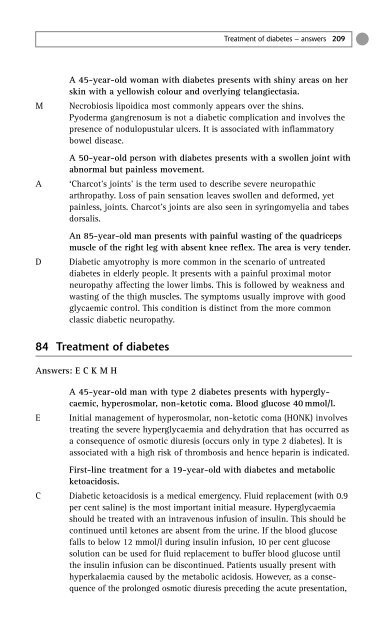EMQs in Clinical Medicine.pdf - Peshawar Medical College
EMQs in Clinical Medicine.pdf - Peshawar Medical College
EMQs in Clinical Medicine.pdf - Peshawar Medical College
You also want an ePaper? Increase the reach of your titles
YUMPU automatically turns print PDFs into web optimized ePapers that Google loves.
Treatment of diabetes – answers 209<br />
M<br />
A<br />
D<br />
A 45-year-old woman with diabetes presents with sh<strong>in</strong>y areas on her<br />
sk<strong>in</strong> with a yellowish colour and overly<strong>in</strong>g telangiectasia.<br />
Necrobiosis lipoidica most commonly appears over the sh<strong>in</strong>s.<br />
Pyoderma gangrenosum is not a diabetic complication and <strong>in</strong>volves the<br />
presence of nodulopustular ulcers. It is associated with <strong>in</strong>flammatory<br />
bowel disease.<br />
A 50-year-old person with diabetes presents with a swollen jo<strong>in</strong>t with<br />
abnormal but pa<strong>in</strong>less movement.<br />
‘Charcot’s jo<strong>in</strong>ts’ is the term used to describe severe neuropathic<br />
arthropathy. Loss of pa<strong>in</strong> sensation leaves swollen and deformed, yet<br />
pa<strong>in</strong>less, jo<strong>in</strong>ts. Charcot’s jo<strong>in</strong>ts are also seen <strong>in</strong> syr<strong>in</strong>gomyelia and tabes<br />
dorsalis.<br />
An 85-year-old man presents with pa<strong>in</strong>ful wast<strong>in</strong>g of the quadriceps<br />
muscle of the right leg with absent knee reflex. The area is very tender.<br />
Diabetic amyotrophy is more common <strong>in</strong> the scenario of untreated<br />
diabetes <strong>in</strong> elderly people. It presents with a pa<strong>in</strong>ful proximal motor<br />
neuropathy affect<strong>in</strong>g the lower limbs. This is followed by weakness and<br />
wast<strong>in</strong>g of the thigh muscles. The symptoms usually improve with good<br />
glycaemic control. This condition is dist<strong>in</strong>ct from the more common<br />
classic diabetic neuropathy.<br />
84 Treatment of diabetes<br />
Answers: E C K M H<br />
E<br />
A 45-year-old man with type 2 diabetes presents with hyperglycaemic,<br />
hyperosmolar, non-ketotic coma. Blood glucose 40 mmol/l.<br />
Initial management of hyperosmolar, non-ketotic coma (HONK) <strong>in</strong>volves<br />
treat<strong>in</strong>g the severe hyperglycaemia and dehydration that has occurred as<br />
a consequence of osmotic diuresis (occurs only <strong>in</strong> type 2 diabetes). It is<br />
associated with a high risk of thrombosis and hence hepar<strong>in</strong> is <strong>in</strong>dicated.<br />
First-l<strong>in</strong>e treatment for a 19-year-old with diabetes and metabolic<br />
ketoacidosis.<br />
C Diabetic ketoacidosis is a medical emergency. Fluid replacement (with 0.9<br />
per cent sal<strong>in</strong>e) is the most important <strong>in</strong>itial measure. Hyperglycaemia<br />
should be treated with an <strong>in</strong>travenous <strong>in</strong>fusion of <strong>in</strong>sul<strong>in</strong>. This should be<br />
cont<strong>in</strong>ued until ketones are absent from the ur<strong>in</strong>e. If the blood glucose<br />
falls to below 12 mmol/l dur<strong>in</strong>g <strong>in</strong>sul<strong>in</strong> <strong>in</strong>fusion, 10 per cent glucose<br />
solution can be used for fluid replacement to buffer blood glucose until<br />
the <strong>in</strong>sul<strong>in</strong> <strong>in</strong>fusion can be discont<strong>in</strong>ued. Patients usually present with<br />
hyperkalaemia caused by the metabolic acidosis. However, as a consequence<br />
of the prolonged osmotic diuresis preced<strong>in</strong>g the acute presentation,












